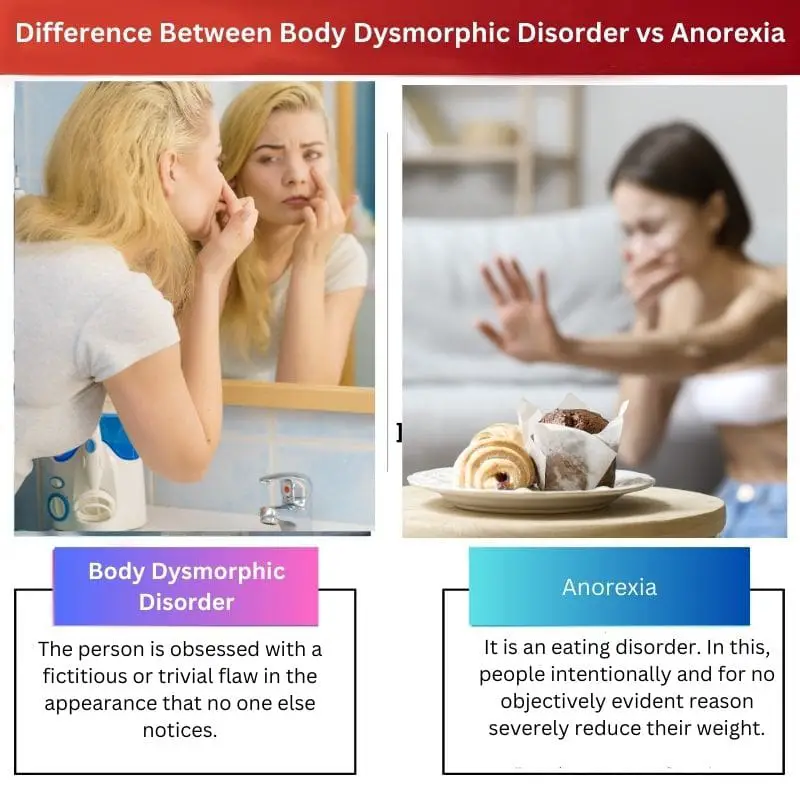It is critical to understand the indications and symptoms of BDD as well as anorexia. These disorders are complex, frightening, and very real.
Moreover, these disorders cause countless people to live lives plagued with agony and misery.
A comprehensive evaluation and accurate diagnosis can make all the difference in assisting people in determining the most successful treatment options accessible to them.
Key Takeaways
- Body dysmorphic disorder (BDD) is characterized by excessive preoccupation with perceived flaws in physical appearance, while anorexia involves a distorted body image and extreme weight loss efforts.
- BDD affects both genders equally and can focus on any body part, whereas anorexia is more common in females and primarily revolves around weight and body shape.
- Treatment for BDD involves cognitive-behavioral therapy and medication, while anorexia requires a combination of medical, nutritional, and psychological interventions.
Body Dysmorphic Disorder vs Anorexia
Body Dysmorphic Disorder (BDD) is a mental health disorder characterized by a preoccupation with perceived flaws or defects in one’s appearance that are either minor or not noticeable to others. Anorexia is an eating disorder characterized by an intense fear of gaining weight or becoming fat.

Body dysmorphic disorder is when an individual becomes preoccupied with an imaginary or minor flaw in one’s body that no one else notices. It is a mental illness.
Often people who suffer from this disease shun social situations or seek cosmetic surgery to enhance their appearance. If this is not treated in its early stage, there is a high chance of making it a chronic problem.
Anorexia is an eating disorder in which people intentionally and for no discernible reason significantly shed and lose weight significantly. It primarily affects puberty-aged girls and young women.
Despite being extraordinarily underweight, patients believe they are fat. Usually, this results in drastic and rapid weight loss in the patients.
Comparison Table
| Parameters of Comparison | Body Dysmorphic Disorder | Anorexia |
|---|---|---|
| Definition | The person is obsessed with a fictitious or trivial flaw in the appearance that no one else notices. | It is an eating disorder. In this, people intentionally and for no objectively evident reason severely reduce their weight. |
| Occurrence | The onset takes place in the initial adolescent years. It can also affect adults and affects both genders equally. | It primarily affects puberty-aged girls and young women. |
| Cause | Causes range from mental illness to emotional instability, and genetic predisposition. | May be caused by factors involving genetics. Psychiatric elements may also contribute to its causes. Personal traits and socio-cultural setups include other causes. |
| Diagnosis | Proper studying of the symptoms can help in diagnosis. Additionally, psychological assessment of behaviors on individual levels or by family can help too. | Diagnosed by physical examination, psychological evaluation, and laboratory tests. |
| Treatment | Treated with medications and psychotherapy. | Treated by rehabilitation and diet treatment, counseling, and work with the patient and family members to create a supportive environment. |
What is Body Dysmorphic Disorder?
In this, a person becomes obsessed with small real or even imaginary flaws in their appearances, which are not visible to most others.
People who suffer from this disease shun social situations or seek cosmetic surgery. This is due to their desire to enhance how they look physically.
Obsessive-compulsive disorder is the term used to describe body dysmorphic conditions. If this is not treated in its early stage, there is a high chance of making it a chronic problem.
Body dysmorphic disorder is a psychiatric condition that is both prevalent and severe.
The onset takes place in the initial adolescent years. It can, however, also affect older people. These people are overly self-conscious and anxious about their ageing process.
This disorder is common among both men and women in similar proportions. Usually, it has been observed that women are more vulnerable to eating disorders.
However, men who engage in muscle and bodybuilding are prone to developing this disorder pretty easily as well.
Individuals with eating disorders are more likely to suffer from body dysmorphic disorder.
The condition has a long-term history, with signs shifting between periods of exacerbation and diminishing. The body part that the patient is concentrating on may remain the same or change over time.
Proper studying of the symptoms can help in diagnosis. Additionally, psychological assessment of behaviours on individual levels or by family can help too.

What is Anorexia?
Anorexia is an eating disorder in which people intentionally and for no discernible reason significantly. In this, people intentionally and for no discernible reason significantly shed and lose weight significantly.
If not looked upon with seriousness, this can take up a life-threatening and persistent form.
Intense workouts, vomiting, purgatives, and stringent low-calorie diets are all used to lose weight. Weight loss is frequently dramatic within a few months. Despite being extraordinarily underweight, patients believe they are fat.
Anorexia primarily affects puberty-aged girls and young women. Male patients make up less than five percent of the total cases of reported anorexics.
It may be caused by factors involving genetics. Psychiatric elements may also contribute to its causes. Personal traits and socio-cultural setups include other causes.
Physical examination, psychological evaluation, and laboratory tests can help in the diagnosis of this eating disorder.
Its treatment includes various techniques ranging from rehabilitation and diet treatment to therapy and working with the patient and family members to create a supportive and safe environment.
It is an eating disorder in which people obsess over their weight and what they consume. Anorexia includes distorted body image and unfounded fear of obesity.
Symptoms include fasting or excessive activity in an attempt to keep the weight below normal. To regain normal weight, medical therapy may be required. Self-esteem and behavioural improvements can both benefit from talk therapy.

Main Differences Between Body Dysmorphic Disorder and Anorexia
- A person with Body Dysmorphic Disorder(BDD) is overly focused on a fictitious or trivial appearance flaw that no one notices, while anorexia is an eating disorder. In this, people intentionally and for no objectively evident reason severely reduce their weight.
- The occurrence of BDD and Anorexia also differs. The onset of the former takes place in the initial adolescent years. It can also affect adults and affects both genders equally. On the other hand, anorexia primarily affects puberty-aged girls and young women. Male patients make up less than five percent of the total cases of reported anorexics.
- The causes of BDD range from mental illness to emotional instability and genetic predisposition, whereas Anorexia may be caused by factors involving genetics. Psychiatric elements may also contribute to its causes. Personal traits and socio-cultural setups include other causes.
- The BDD diagnosis is based on examining the symptoms, personal, family, and social history, and psychological assessment of the behaviour, feelings, and ideas associated with a negative self-image. On the other hand, Physical examination, psychological evaluation, and laboratory tests can help in the diagnosis of anorexia.
- The treatments of BDD also differ greatly from that of Anorexia. The former is treated with various medications. Psychotherapy may also help in certain cases. However, the latter requires rehabilitation of the patient and the treatment of their diets. Counselling may also help in certain cases. Working with the patients and their family members to create a safe environment suited for recovery can also greatly assist.




